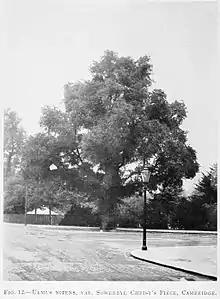Ulmus minor 'Sowerbyi'
The Field Elm cultivar Ulmus minor 'Sowerbyi', commonly known as the Sowerby Elm, was described (as Ulmus nitens var. sowerbyi Moss) by Moss[1] in The Cambridge British Flora (1914).[2] The tree, once referred to as the 'Norfolk Elm' by Smith, was commonly found in the hedgerows and woods of Norfolk, Cambridgeshire, and Huntingdonshire in the early 20th century before the advent of Dutch elm disease.[3] Melville considered it a hybrid of 'Coritana'.[4]
| Ulmus minor 'Sowerbyi' | |
|---|---|
 'Sowerbyi', Christ's Piece, Cambridge before 1915 | |
| Species | Ulmus minor |
| Cultivar | 'Sowerbyi' |
| Origin | England |
The tree was named for the botanical artist James Sowerby, who had illustrated it in English Botany, or Coloured Figures of British Plants (1863, figure T.2248),[2] from a specimen collected in Essex c.1810 and now in the Borrer Herbarium at Kew.[5][6]
Description
A smaller tree than 'Hunnybunii', the branches shorter and the upper ones very tortuous; leaves smaller and acute.[7] The obovate to elliptical fruits are also smaller than 'Hunnybunii'.[3]
.jpg.webp) 'Sowerbyi', from English Botany, or Coloured Figures of British Plants.[2]
'Sowerbyi', from English Botany, or Coloured Figures of British Plants.[2]
Pests and diseases
Though susceptible to Dutch Elm Disease, field elms produce suckers and usually survive in this form in their area of origin.
Cultivation
Moss in The Cambridge British Flora (1914) described 'Sowerbyi' as "often planted, as on Christ's Pieces, Cambridge".[2] The Christ's Pieces tree stood at the junction of Parker Street and Emmanuel Road[8][9] and was (1932) 77 ft (23 m) high, with a diameter of 5.5 ft (1.7 m) towards the base and the branches spread 72 ft (22 m) across.[10] Herbarium specimens from Wageningen suggest that the tree was cultivated in The Netherlands in the mid-20th century, possibly as part of the elm collection assembled there the 1930s for DED-testing by Christine Buisman, on behalf of the Dutch Elm Committee. No mature specimens are known to survive.
References
- kiki.huh.harvard
- Moss, C. E.; Hunnybun, E. W. (1914). The Cambridge British Flora. Vol. 2 Text. p. 90. Retrieved 13 December 2017.
- Lynch, R I. (1915). Trees of the Cambridge Botanic Garden, in Journal of the Royal Horticultural Society (Ed.: Chittenden), Vol. 41, part 1, p.16, 1915.
- Melville, Ronald (1949). "The Coritanian Elm". Journal of the Linnean Society of London, Botany. 53 (352): 263–271. doi:10.1111/j.1095-8339.1949.tb00418.x.
- Melville, Ronald (1946). "Typification and Variation in the Smooth-Leaved Elm, Ulmus carpinifolia Gleditsch". Journal of the Linnean Society of London, Botany. 53 (349): 83–90. doi:10.1111/j.1095-8339.1946.tb00409.x. ISSN 0368-2927.
- William Borrer, Ulmus, herbariaunited.org
- Green, Peter Shaw (1964). "Registration of cultivar names in Ulmus". Arnoldia. 24 (6–8): 41–80. Retrieved 16 February 2017.
- "Britain From Above EAW018195". britainfromabove.org.uk. Retrieved 2017-12-15.
- "Britain From Above EAW018201". britainfromabove.org.uk. Retrieved 2017-12-15.
- Gilmour, J. S. L.; Stearn, W. T. (1932). "Notes from the University Herbarium, Cambridge". Journal of Botany. 70 (Supplement): 29.
External links
- "Herbarium specimen - L.4214758". Botany catalogues. Naturalis Biodiversity Center. Samarae labelled Ulmus nitens var. sowerbyi; Christ's Piece corner, Cambridge, 1938
- "Herbarium specimen - WAG.1852725". Botany catalogues. Naturalis Biodiversity Center. Formerly labelled U. foliacea 'Sowerbyi'; Wageningen specimen, 1962
- "Herbarium specimen - WAG.1852724". Botany catalogues. Naturalis Biodiversity Center. Formerly labelled U. foliacea 'Sowerbyi'; Wageningen specimen, 1962